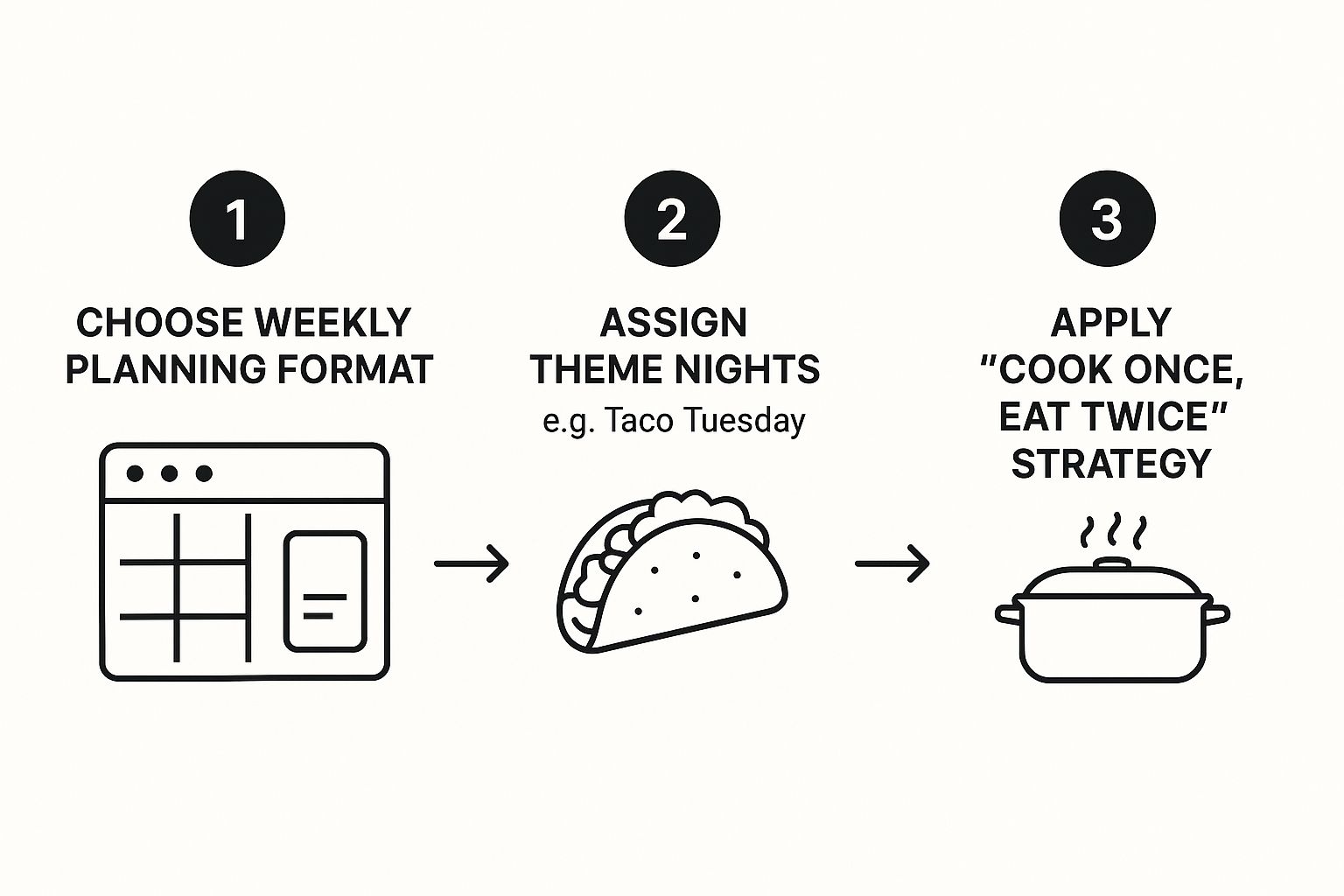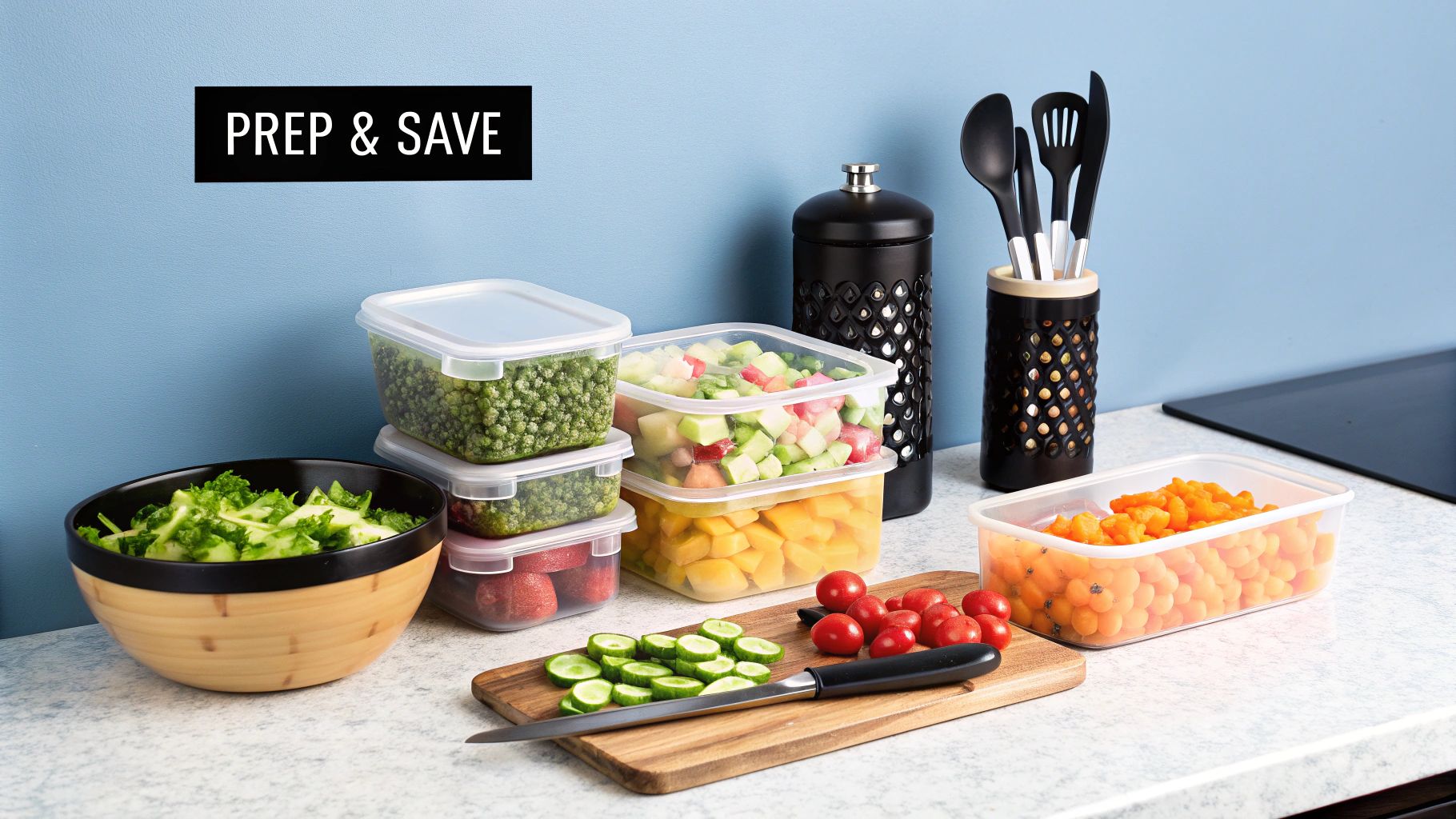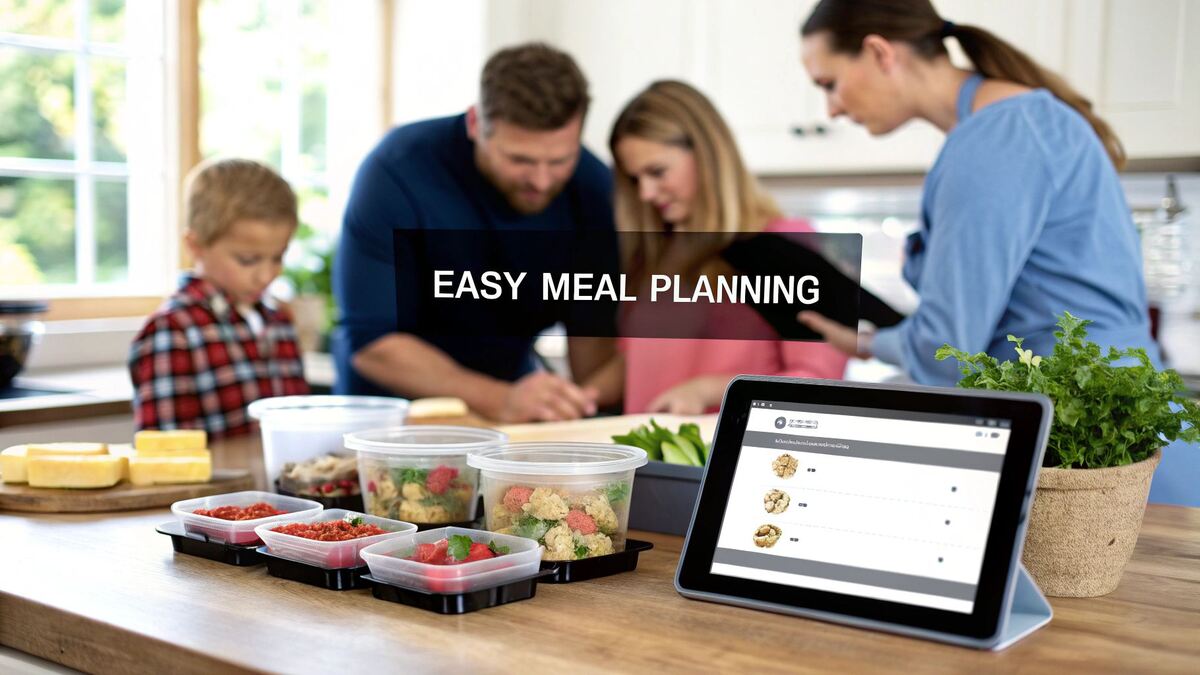Easy Meal Planning for Families That Actually Works
At its heart, easy meal planning for families is all about one thing: making decisions before you're tired and hungry. It's a simple system. You figure out what you’ll eat for the week, turn that into a shopping list, and maybe prep a few things ahead of time. That single hour you spend on a Sunday can completely erase the weeknight chaos of scrambling for dinner or ordering last-minute takeout.
Why Meal Planning Is a Family Game Changer

That relentless "what's for dinner?" question adds a layer of stress to every evening, slowly wearing you down. Meal planning isn't just another chore to add to the list—it's a genuine strategy for getting back your time, freeing up mental space, and bringing a little calm back into your home.
When you trade that daily indecision for a weekly plan, dinner shifts from a source of anxiety to a predictable, even enjoyable, part of the day. And that small change has a huge ripple effect on your family's well-being.
It's About More Than Just a Menu
Once you get into a groove with easy meal planning for your family, you start to notice some real, tangible benefits that pop up in your daily life.
- You'll Save Money: A clear plan means no more impulse buys at the grocery store or expensive last-minute food delivery. You shop with purpose, which can seriously cut down your grocery bills.
- You'll Waste Less Food: Planning meals around ingredients you already have (and buying only what you actually need) means you finally stop discovering fuzzy vegetables in the back of the fridge.
- You'll Eat Better: When you're in control, it's so much easier to put together balanced, home-cooked meals. You're not just reaching for whatever processed food is fastest.
- You'll Stress Less: Just imagine walking in the door after a long day already knowing what's for dinner and that you have everything you need to make it. It removes a huge source of evening friction.
A solid meal plan is built on a few key ideas that work together. Understanding them helps the whole process click into place.
The Core Pillars of Successful Family Meal Planning
| Pillar | Why It's Important | Quick Tip |
|---|---|---|
| Consistency | Making it a weekly habit turns a chore into an automatic routine. | Pick a day and time that works every week, like Sunday afternoon, and stick to it. |
| Simplicity | Overly complex plans are doomed to fail. Stick to familiar, easy-to-make recipes. | Start with just 3-4 planned dinners a week and allow for leftovers or a night off. |
| Flexibility | Life happens. A good plan has wiggle room for unexpected schedule changes. | Pencil in a "Leftover Night" or "Pantry Raid" so you can swap days around if needed. |
| Involvement | Getting the family to help with planning increases buy-in and reduces complaints. | Let each family member pick one meal for the week to ensure everyone has something to look forward to. |
These pillars aren't just abstract concepts; they are the practical foundation that makes meal planning a sustainable habit rather than a one-time effort.
The Power of a Shared Meal
Beyond all the practical stuff, meal planning helps create space for connection. We live in an age where eating alone is becoming more and more common. In 2023, one in four Americans reported eating all their meals by themselves—that’s a staggering 53% increase from 2003.
Yet, study after study shows that eating together makes people happier and healthier. When you plan your meals, you’re also planning to connect.
The goal isn’t to cook gourmet food every night; it's to be consistent. A predictable, shared meal can become a comforting anchor in your family's busy week, opening the door for real conversation.
Ultimately, finding a system for easy meal planning for families is about making your life simpler. Tools like an AI Meal Planner can take this a step further, generating plans that are customized to your family's specific tastes and dietary needs. You're just investing a little bit of time upfront to get a whole lot more peace and presence back in return.
Defining Your Family's Meal Planning Mission

Before you even think about recipes or grocery lists, let's talk about the single most important step: figuring out why you’re doing this. I've seen countless families jump into a generic template only to give up a week later. The reason is simple—their plan had no mission.
Is your main driver slashing that grocery budget that seems to inflate every month? Or maybe you're just trying to get more veggies on your kids' plates without the nightly dinner table drama. For many of us, it’s about wrestling back control of our weeknights from the chaos of takeout menus and last-minute trips to the store.
Having a clear mission turns a fuzzy idea like "we should eat better" into a real, motivating target. It's the difference between wandering around the grocery store and walking in with a map.
What Is Your Top Priority?
First things first, sit down with your family for a quick, honest chat. You don't need a formal meeting—a casual five-minute conversation over dinner is perfect. The goal is to uncover your core motivation.
What's the biggest pain point you're trying to solve right now? Is it time, money, or health? Most of us are trying to juggle all three, but there's usually one that feels most urgent.
- Money-Focused: Are your grocery receipts starting to look like a car payment? Your mission is probably to cut down on food spending and waste.
- Time-Focused: Feeling like there’s zero breathing room between work, school, and after-school activities? Your goal is to get dinner on the table faster and with less stress.
- Health-Focused: Are you trying to introduce more variety, manage a new dietary need, or simply eat more real, whole foods? Your mission is all about nutrition.
Once you know your main driver, you can build a plan that actually tackles that problem head-on. That's when you start to see real results.
Turning Vague Ideas Into Actionable Goals
Okay, so you’ve pinpointed your main priority. Now, let’s make it real. A vague goal is just a wish, but a specific target gives you something concrete to work toward.
Instead of just "save money," your goal becomes "reduce our grocery bill by 15% this month." See the difference? It's specific, measurable, and has a clear timeline.
Here are a few more examples of how to turn those general ideas into missions that actually work:
- Vague Idea: "We need to eat less takeout."
- Actionable Goal: "We will eat a home-cooked dinner at least five nights a week."
- Vague Idea: "The kids should eat more vegetables."
- Actionable Goal: "We will introduce one new vegetable side dish each week."
- Vague Idea: "I want to be healthier."
- Actionable Goal: "We will try one meatless meal every Monday to diversify our protein sources."
A clear, specific mission is your compass. When you feel overwhelmed on a busy Tuesday and that pizza delivery app is calling your name, remembering your goal—like saving that extra $200 for a family outing—is what keeps you on track.
This simple process ensures you’re creating a system that truly serves your family's unique needs. For those focused on nutrition, starting with a balanced meal plan can be a fantastic way to get expertly crafted recipes and ideas. Ultimately, a solid mission saves you from adopting a one-size-fits-all plan that you’ll ditch by next Wednesday.
How to Create a Flexible Weekly Meal Template
The secret to a great meal plan isn't about strict rules; it's about building a flexible framework that can handle the beautiful chaos of family life. Think of it as your roadmap, not a rigid contract. The best templates can work around a late meeting, unexpected soccer practice, or those nights you’re just too exhausted to think.
The goal here is to build a reusable system that takes the guesswork out of your week, turning meal planning from a chore into a simple, calming routine.
This is where the magic really happens—turning an idea into something you can actually see and use every day. You don't need fancy software. Honestly, the best tool is whatever you'll actually stick with.
This flow chart gives you a bird's-eye view of how to move from choosing a format to putting smart, time-saving strategies into action.

This visual breaks it all down: the core steps to building a sustainable system that gets rid of the nightly "what's for dinner?" debate and makes your ingredients work harder for you.
Find Your Format: Physical or Digital
First things first, you need to decide where your plan is going to live. There are really two main paths here, and both work great—it’s all about what feels right for you and your family.
The Kitchen Whiteboard: This one is a classic for a reason. A simple magnetic whiteboard stuck to the fridge becomes a central hub for the whole family. The kids can see what's coming up, and you have a constant, visible reminder of the plan. It's low-tech, super easy to update, and makes the meal plan a shared family thing.
The Shared Digital Doc: If your family is a bit more digitally wired, a shared document like a Google Sheet or even a note in an app you all use can be a game-changer. You can access it and make changes from anywhere—perfect for adding an ingredient you forgot while you're out or checking the plan from your desk. Plus, copying and pasting the template for the next week takes seconds.
Whatever you choose, the key is to make it visible and accessible. A plan hidden away in a notebook is a plan that's going to get forgotten.
Introduce Theme Nights to Beat Decision Fatigue
Now for the fun part that makes easy meal planning for families truly effortless: theme nights. This is hands-down one of the most powerful tricks for simplifying your week. Instead of staring at seven blank slots, you just have to fill in the blanks for themes you've already decided on.
This simple structure slashes the mental load of planning. You’re not starting from scratch; you're just picking a specific recipe within a category everyone already likes.
Here’s what a sample week could look like:
- Meatless Monday: Think black bean burgers, a hearty lentil soup, or a creamy spinach baked pasta.
- Taco Tuesday: This is always a guaranteed family favorite. You can easily rotate between ground beef, shredded chicken, or fish tacos to keep it fresh.
- Crockpot Wednesday: Let your slow cooker do all the heavy lifting with pulled pork for sandwiches, a rich beef stew, or even meatball subs.
- "Anything Goes" Thursday: This is your flex day! It’s perfect for using up leftovers, having breakfast for dinner, or throwing together a quick pantry meal.
- Pizza Friday: Kick off the weekend with homemade pizzas where everyone adds their own toppings, or just go with your favorite takeout spot.
Theme nights create a predictable rhythm that both kids and adults really appreciate. It builds anticipation (everyone looks forward to Pizza Friday!) and turns the planning process into a simple game of fill-in-the-blank.
Cook Once, Eat Twice
Another cornerstone of a truly flexible template is the "Cook Once, Eat Twice" philosophy. And no, this doesn't mean eating the exact same dinner two nights in a row. It’s about being strategic—cooking core components that you can repurpose into entirely new meals later.
This approach is a massive time and energy saver during a busy week. One cooking session can lay the foundation for two, or even three, different meals.
Here’s how it works in real life:
- Roast a big chicken on Sunday. Serve it as a traditional roast for Sunday dinner. Then, shred the leftovers for chicken tacos on Tuesday and use the carcass to make a quick, nourishing chicken noodle soup on Thursday.
- Make a huge batch of chili. Have it in bowls with all the fixings the first night, then use the rest to top baked potatoes or hot dogs later in the week.
- Grill extra chicken breasts. Slice them up and keep them in the fridge for lightning-fast salads, wraps, or quesadillas for weekday lunches.
This kind of system provides the structure that helps families eat together more consistently. Research backs this up, showing that routines are a huge help. While about 49.12% of adolescents across 43 countries eat with their families daily, that number jumps to 63.6% in families where both parents work—suggesting routines like meal planning are key. You can learn more about how family structure impacts shared mealtimes in the full study on family meals. A simple template system gives you exactly that kind of essential structure.
Your Go-To Recipe List and Smart Shopping System
Let’s be honest, the real secret to sticking with family meal planning isn’t discovering some revolutionary recipe every week. It's about building a solid, family-approved arsenal of meals you can fall back on without a second thought. This is your personal playbook, the foundation that makes everything else work.
From there, it’s all about bridging the gap between that plan and the grocery store. A great meal plan is only as good as the shopping trip that supports it. So, let’s get into turning your weekly menu into an organized, efficient shopping system that genuinely saves you time, money, and sanity.
Build Your Master Recipe List
Think of this as your family’s private cookbook. It’s a living document—maybe a note on your phone, a page in a binder, or a simple spreadsheet—filled with certified wins. Having this list on hand completely removes the mental block of staring at a blank page.
Start by just jotting down every single meal your family actually enjoys. Don't overthink it. If frozen pizza with a side salad is your Friday night ritual, it belongs on the list. The goal here is to capture reality, not to create a Pinterest-perfect fantasy.
Once you have a good brain dump, you can start organizing it into practical categories that mirror your real life. This makes plugging meals into your weekly template a breeze.
Helpful Categories for Your List:
- 30-Minute Dinners: For those chaotic weeknights. Think quick pasta dishes, sheet-pan sausages with veggies, or black bean quesadillas.
- Slow Cooker Favorites: The "set it and forget it" meals you can start in the morning, like pulled pork, lentil soup, or a simple beef stew.
- Picky Eater Wins: These are the guaranteed hits that everyone—even your most selective eater—will eat without complaint. For a lot of us, this means tacos or spaghetti.
- "Cook Once, Eat Twice" Meals: Roasts, big batches of chili, or grilled chicken that you know will give you valuable leftovers for another meal.
Your master list is a tool, not a test. It’s designed to save you mental energy. When you sit down to plan, you’re not starting from zero; you’re simply "shopping" from a curated menu of your family's greatest hits.
As you build out your family's go-to recipe list, it’s a great opportunity to weave in nutrient-dense options that also support gut health. Including meals rich in natural probiotic food sources can be a simple way to boost everyone's wellness. For anyone curious about plant-based options, our guide to creating a delicious and balanced vegetarian meal plan has plenty of family-friendly ideas to add to your rotation.
The Five-Minute Pantry and Fridge Scan
Before you even think about writing a grocery list, you have to do this. It’s a critical five-minute ritual. Just open your fridge, freezer, and pantry, and take a quick inventory of what you already have. I can’t stress this enough—this simple habit is the number one way to prevent food waste and stop overspending.
That half-bag of wilting spinach, the block of cheddar, and that forgotten can of black beans aren't just clutter; they're meal starters. This scan helps you plan meals around what needs to be used up, saving you from buying duplicates and making sure good food doesn't end up in the bin.
Make a quick list of what you find:
- Proteins: What chicken, ground beef, or beans do you have?
- Produce: Which vegetables and fruits need to be eaten soon?
- Pantry Staples: Note any pasta, rice, or canned goods you can build a meal around.
This quick check directly informs your meal plan for the week. See some ground beef and a can of tomatoes? Spaghetti night just planned itself.
Translate Your Plan Into a Smart Shopping List
With your meal plan set and your pantry scanned, creating the grocery list is the final piece of the puzzle. The key to an efficient trip is all in the organization. A random list of items is a recipe for backtracking through crowded aisles and tossing impulse buys into your cart.
Instead, organize your list by store section. It’s a simple trick that mirrors how most grocery stores are laid out, letting you move through the aisles logically and get out of there much faster.
Sample Aisle-by-Aisle List Structure:
- Produce: Onions, bell peppers, lettuce, apples
- Meat & Deli: Ground beef (1 lb), chicken breasts, sliced turkey
- Dairy & Refrigerated: Milk, yogurt, eggs, shredded cheddar
- Aisles (Dry Goods): Pasta, black beans, taco shells, olive oil
- Frozen: Corn, peas, fish sticks
This structured approach transforms shopping from a chaotic chore into a streamlined mission. You’ll find you spend less time in the store, which studies have shown directly correlates to spending less money. A focused list is your best defense against all the marketing designed to make you buy things you don't actually need. This is how easy meal planning for families moves from the kitchen table to the checkout line, saving you real money every step of the way.
Mastering Prep and Time-Saving Kitchen Hacks

This is where your meal plan transforms from a piece of paper into real, time-saving action. Investing just an hour or two over the weekend can completely change the dynamic of your busy weeknights. The goal isn’t to spend your entire Sunday chained to the kitchen; it’s about smart, high-impact prep that pays you back tenfold.
We’re talking about tackling the most tedious tasks upfront. This strategy, often called batch prepping, is the secret sauce for families who want to eat well without the nightly chaos. It turns the dinner rush into a calm, manageable assembly process.
Focus on High-Impact Prep Tasks
Forget trying to cook five different gourmet meals on a Sunday. The most effective prep focuses on simple, repetitive jobs that make the biggest difference during the week. By getting these out of the way, you remove the biggest hurdles to starting dinner on a tired Tuesday evening.
A great way to get started is by thinking about what slows you down the most. Is it chopping vegetables? Measuring out spices? Waiting for grains to cook? Target those bottlenecks first.
Spending a little time upfront on these tasks can save you precious minutes—and your sanity—every single night.
High-Impact Weekly Prep Tasks
Here's a look at some of the best-bang-for-your-buck prep tasks you can knock out in a couple of hours. This isn't about cooking full meals, but about creating components that make cooking fast and easy.
| Prep Task | Time Estimate | Impact on Weekday Meals |
|---|---|---|
| Chop Base Veggies | 20-25 mins | Instantly start soups, stir-fries, and sautés. No peeling or chopping required. |
| Cook a Staple Grain | 15-20 mins (passive) | Build quick grain bowls, side dishes, or add to salads and soups. |
| Wash & Dry Greens | 10-15 mins | Makes throwing together a side salad or adding greens to a wrap effortless. |
| Mix Marinades/Dressings | 10 mins | Proteins can be marinating and ready to cook; salads come together in seconds. |
Completing even just two or three of these tasks will make your weeknights feel significantly less hectic.
And, of course, whenever you're prepping food for the week, it's crucial to follow safe handling practices. Brushing up on the best ways to prevent foodborne illness helps keep your family healthy and your prepped food fresh.
Cook Components, Not Full Meals
One of the biggest mistakes people make is thinking meal prep means five fully cooked, identical dinners lined up in the fridge. A much more flexible approach is to prep components that can be mixed and matched. This prevents food boredom and gives you wiggle room in your schedule.
For instance, browning a large batch of ground beef is a game-changer. On Monday, half of it becomes the star of your taco night. On Wednesday, the other half is ready to be turned into a quick spaghetti sauce or a shepherd's pie.
By prepping versatile ingredients instead of complete dishes, you create building blocks for your week. One prep session can support several different meals, giving you both speed and flexibility.
Another fantastic example is cooking a big batch of shredded chicken in the slow cooker. You can use it throughout the week for chicken salad sandwiches, quesadillas, or as a topping for a quick pizza. Dinnertime starts to feel more like assembling a puzzle than cooking from scratch.
Build Your Emergency Meal Stash
Let's be realistic: even the best meal plan can get derailed by a sick kid, a late meeting, or just pure exhaustion. This is why having a stash of freezer-friendly "emergency meals" is a non-negotiable part of any sustainable system. Think of it as your family's safety net.
These emergency meals are your backup plan—simple, low-cost dinners you can get on the table in under 20 minutes with almost no effort.
- Frozen Soups and Chilis: Next time you make a big pot, double it and freeze half in family-sized portions.
- Breakfast for Dinner: Keep frozen waffles or pancake mix on hand with a carton of eggs. It’s always a winner.
- DIY Pizza Kits: Freeze individual pizza dough balls, a bag of shredded mozzarella, and keep a jar of sauce in the pantry.
These simple hacks bridge the gap between planning and real life, making your week smoother, less stressful, and a whole lot more delicious.
Got Questions? We’ve Got Answers.
Even with a great template, life happens. It’s totally normal to hit a few roadblocks when you’re trying to get a meal planning rhythm going. Let's walk through some of the most common sticking points I hear from families and talk about real-world solutions that actually work.
Think of these challenges not as failures, but as chances to fine-tune your family’s unique system. A little bit of flexibility and a few clever tricks are all it takes to make this work for the long haul.
"What Do I Do About My Picky Eater?"
Ah, the age-old dinner table struggle. This is probably the #1 concern for parents, but I promise, your meal plan can become a tool for peace, not a battleground.
One of the best things you can do is serve meals "deconstructed." Instead of handing over a fully assembled taco, set up a mini taco bar with the seasoned meat, cheese, lettuce, tomatoes, and tortillas in separate bowls. This small change is a game-changer. It gives kids a sense of control and empowers them to build their own plate, which dramatically increases the odds they'll actually eat without a fuss.
Another strategy that works wonders is to always include one "safe" food with every meal. This is something you know your child likes and will eat—a dinner roll, some plain pasta, a few cucumber slices. It takes the pressure off everyone and makes them more willing to eye the other foods on their plate.
The goal here is low-pressure exposure, not a dinner-table showdown. When kids feel in control and see a familiar, liked food on their plate, their anxiety around new foods decreases, making them more adventurous eaters in the long run.
"How Can I Possibly Meal Plan on a Super Tight Budget?"
Meal planning isn't just about getting organized; it's hands-down one of the most effective ways to slash your grocery bill. When every dollar counts, a solid plan is your secret weapon against impulse buys and overspending.
First things first: always check the weekly sales flyers before you plan a single meal. Build your menu around the proteins and produce that are on sale that week. This one habit alone can make a huge dent in your spending.
Next, you'll want to lean into budget-friendly workhorses. These are the staples of any frugal kitchen:
- Legumes: Lentils and beans are protein and fiber powerhouses that cost pennies on the dollar compared to meat.
- Eggs: Incredibly versatile and one of the most affordable sources of high-quality protein you can buy.
- Seasonal Produce: Veggies and fruits that are in season are always cheaper, and they taste so much better, too.
Finally, get into a "waste-nothing" mindset. That Sunday roast chicken? It can become chicken salad sandwiches for Monday's lunch and the base for a hearty chicken noodle soup on Wednesday. Toss leftover veggies into a frittata or stir-fry before they have a chance to go bad.
"My Schedule Is a Mess. How Can I Create a Flexible Plan?"
If your family’s schedule is all over the place, a rigid, day-by-day plan is doomed from the start. For busy families, flexibility isn’t a luxury—it’s a necessity.
So, instead of assigning a specific meal to each day, try a more fluid approach. At the beginning of the week, just list out five to seven dinner ideas without locking them into certain nights. Each morning, you can glance at your list and choose the meal that best fits the time and energy you have for that day. This lets you pivot on a dime.
Another brilliant tactic is to always have three "emergency meals" ready to go. These are your 15-minute saviors, made from pantry or freezer staples, for those nights when everything goes off the rails.
A few of our go-to emergency meals:
- Black bean quesadillas with canned beans, cheese, and tortillas.
- Pasta with a jar of good pesto and a handful of frozen peas.
- Good old "breakfast for dinner"—scrambled eggs and toast never fails.
Having a flexible list combined with a reliable backup plan makes easy meal planning for families a real possibility, no matter how chaotic life gets.
Ready to take the guesswork out of your weekly menu for good? The AI Meal Planner creates personalized meal plans based on your family's unique tastes, dietary needs, and schedule. Stop staring at a blank page and let us build a delicious, easy-to-follow plan for you. Get started with your custom meal plan today at https://ai-mealplan.com.
AI-powered nutrition
Get Your Personalized Meal Plan
AI creates the perfect meals for your goals, lifestyle, and taste.
Start Your Journej
